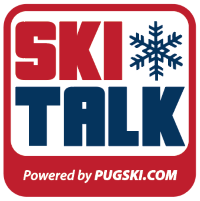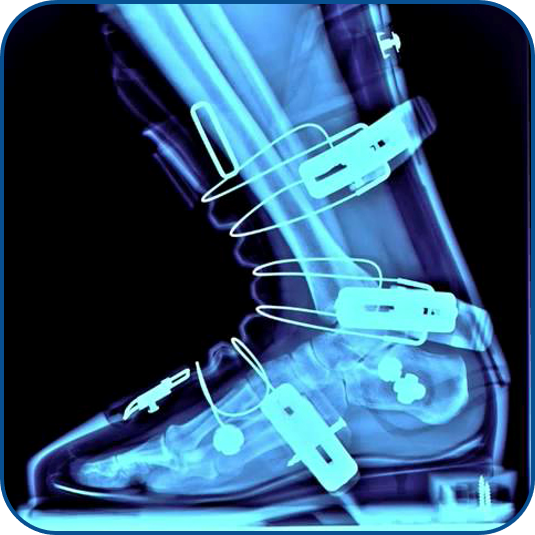I have very flexible ankles and big calves.
My daughter recently observed that I ski "like I'm sitting down" and I suddenly realized maybe that's why I have trouble getting forward enough to feel pressure under my forefoot.
I have long understood that "crushing" my shins into the tongues of my boot, done incorrectly, sends pressure to the heels and causes the forefoot to lift. But despite being aware of this movement pattern I have long had trouble "just leaning forward" with my weight over the balls of my feet.
So I did the "obvious" thing and removed as much forward lean adjustment from my old Head Vector S120 boots as possible.
All of a sudden not only did I feel myself standing taller and more relaxed (perhaps obviously), but I finally experienced what it truly means to get forward over the balls of my feet. Pressure on my boot tongue now just feels like an enhancement of that forward positioning.
(For those who follow Carv, I went from 40% Early Forward Movement and 40% Mid-Turn Centered Balance to 80% on both).
I'm looking forward now to experimenting with reducing boot ramp angle — and perhaps one day adding back forward lean as I become more proficient — but I first wanted to make sure I understood why @otto (and others) advises increasing forward lean for a flexible ankle:
18 degrees is on the flexible side of average. If it is affecting fit or fore/aft balance, you bring the net FL formula back in line by increasing the shells forward lean with wedges or shims between the shell and the liner. This gives you a higher FL number to subtract the bootboard angle from. You could also either raise the forefoot of the bootboard a mm or 2, or lower the heel height a mm or 2. ( only if the fit can still be rock solid holding the heel down and back in the shell.) So if yo can raise the FL of the spoiler to 20 degrees and lower the bootboard to 2 degrees, your net FL will be 18 degrees... Since that is a love match, off you go!!!

 www.skitalk.com
www.skitalk.com
Yet, @otto (and others) also recommends elsewhere what I actually started started with, reducing forward lean for flexible ankles with high range of motion:
Lowering the heel or raising the bootboard toe, will take a few degrees of movement out of the loose ankle joint. Combine that with a straighter upright boot shell that is stiffer and harder to over flex, will normalize the long range of motion that a typical high ROM ankle has.

 www.skitalk.com
www.skitalk.com
I assume the reason for the disparate recommendations is because "it's all personal", a la @Rod9301's:
Not always true that more forward lean is easier to pressure the tips.
Often it causes the butt to stick out.

 www.skitalk.com
www.skitalk.com
My daughter recently observed that I ski "like I'm sitting down" and I suddenly realized maybe that's why I have trouble getting forward enough to feel pressure under my forefoot.
I have long understood that "crushing" my shins into the tongues of my boot, done incorrectly, sends pressure to the heels and causes the forefoot to lift. But despite being aware of this movement pattern I have long had trouble "just leaning forward" with my weight over the balls of my feet.
So I did the "obvious" thing and removed as much forward lean adjustment from my old Head Vector S120 boots as possible.
All of a sudden not only did I feel myself standing taller and more relaxed (perhaps obviously), but I finally experienced what it truly means to get forward over the balls of my feet. Pressure on my boot tongue now just feels like an enhancement of that forward positioning.
(For those who follow Carv, I went from 40% Early Forward Movement and 40% Mid-Turn Centered Balance to 80% on both).
I'm looking forward now to experimenting with reducing boot ramp angle — and perhaps one day adding back forward lean as I become more proficient — but I first wanted to make sure I understood why @otto (and others) advises increasing forward lean for a flexible ankle:
18 degrees is on the flexible side of average. If it is affecting fit or fore/aft balance, you bring the net FL formula back in line by increasing the shells forward lean with wedges or shims between the shell and the liner. This gives you a higher FL number to subtract the bootboard angle from. You could also either raise the forefoot of the bootboard a mm or 2, or lower the heel height a mm or 2. ( only if the fit can still be rock solid holding the heel down and back in the shell.) So if yo can raise the FL of the spoiler to 20 degrees and lower the bootboard to 2 degrees, your net FL will be 18 degrees... Since that is a love match, off you go!!!

Fore/aft alignment when boot shopping
Yes, you can increase the FL number by adding a forward lean wedge. You can also adjust the net FL by either raising the toe of the bootboard a mm or 2. You could also lower the heel height of the bootboard by a mm or 2. This will get you the net FL closest to your measured 15 deg, give or take...
 www.skitalk.com
www.skitalk.com
Yet, @otto (and others) also recommends elsewhere what I actually started started with, reducing forward lean for flexible ankles with high range of motion:
Lowering the heel or raising the bootboard toe, will take a few degrees of movement out of the loose ankle joint. Combine that with a straighter upright boot shell that is stiffer and harder to over flex, will normalize the long range of motion that a typical high ROM ankle has.

Forward Lean
I have question (i read blog Mr. Colin "Ankle Flex"). My ski boot have forward lean 15 degrees, but my ankle forward lean max (if my balance is ok) is about 35 degrees. Should i explore/quest this issue?
 www.skitalk.com
www.skitalk.com
I assume the reason for the disparate recommendations is because "it's all personal", a la @Rod9301's:
Not always true that more forward lean is easier to pressure the tips.
Often it causes the butt to stick out.

Forward Lean
More forward lean puts you naturally in a more forward stance-easier to pressure the tips. However too much of it makes you lose the contact with the tails which is no good on twin tips, powder ski etc. I ski 16 degrees on groomers and stiff skinny ski and 12 degrees on fatter skis Not always...
 www.skitalk.com
www.skitalk.com








